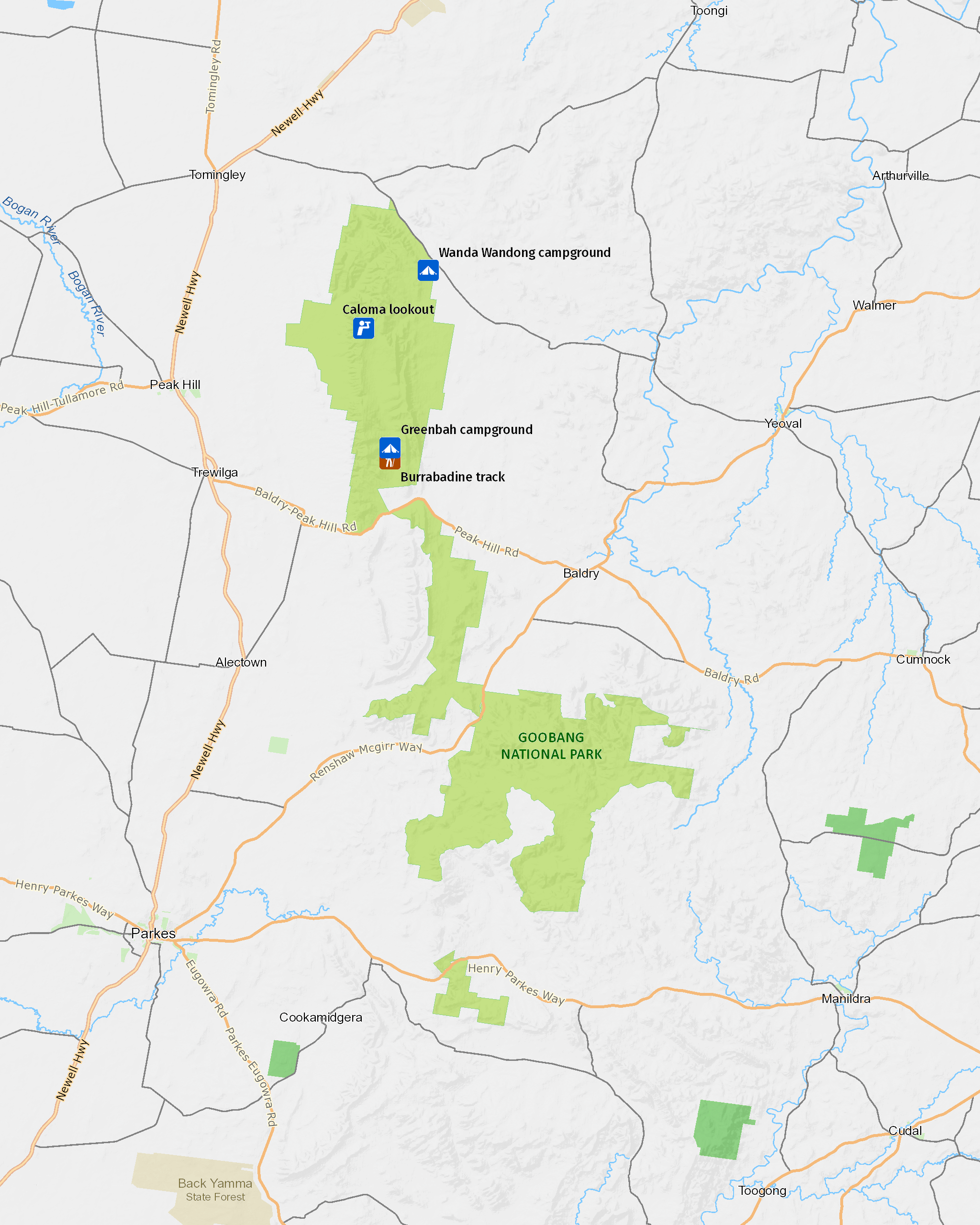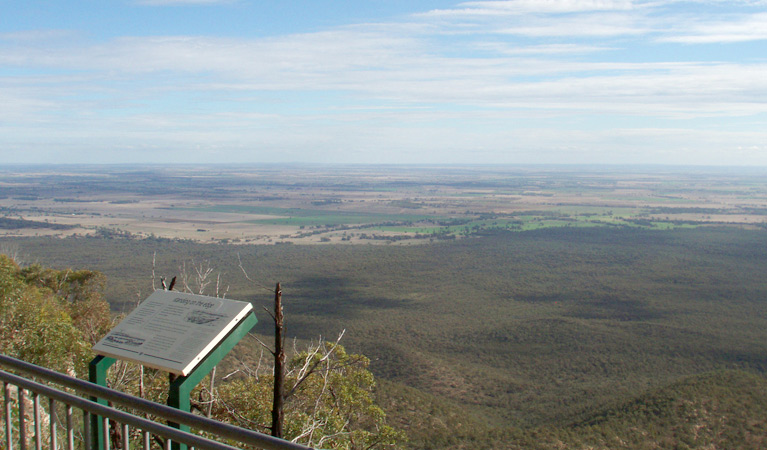Goobang National Park
Overview
Goobang National Park, near Dubbo, between Peak Hill, Parkes and Molong, offers scenic views, bush walking, bush camping, picnic areas, mountain biking trails, and 4WD touring.
Read more about Goobang National Park
Goobang National Park, near Parkes and Dubbo, is a central NSW gem. Whether you’re exploring the park by car, mountain bike, or going on a bushwalk, there’s so much to see. Be sure to pack your binoculars if you like birdwatching as there are loads of species to spot, from owls and eagles to parrots and small wrens.
If you’re staying at one of the idyllic bush campsites, with their friendly and relaxed feel, you’re likely to encounter many of the park’s other inhabitants. Red-necked wallabies, swamp wallabies, eastern grey kangaroos and echidnas may be seen all year round.
During the sunlit days of spring and summer, reptiles are on the move. Keep an eye out for lace monitors, blue-tongued lizards, shingle backs and bearded dragons. There have even been sightings of koalas in the quieter areas of the park. At night, boobook owls, nightjars, possums, bats, and a variety of frogs can be heard calling or scurrying about.
Local alerts
For the latest updates on fires, closures and other alerts in this area, see https://www.nationalparks.nsw.gov.au/visit-a-park/parks/goobang-national-park/local-alerts
Contact
- in the Country NSW region
Goobang National Park is always open but may have to close at times due to poor weather or fire danger.
-
-
Bathurst office
02 6332 7640
02 6332 7680 To contact the KARST Conservation Unit in this office.
Contact hours: Monday to Friday, 8.30am to 4.30pm. - Level 2, 203-209 Russell Street, Bathurst NSW 2795
-
Email: npws.centralwest@environment.nsw.gov.au
-
Bathurst office
Visitor info
All the practical information you need to know about Goobang National Park.
Map

Map legend

Maps and downloads
Nearby towns
Peak Hill (27 km)
Peak Hill is a peaceful country town with a rich mining history. It's free to visit Peak Hill Open Cut Experience to view the mine over five open cuts, historic mine workings and old mining equipment. Opening times vary depending on the season.
Parkes (50 km)
Even though Elvis Presley died in 1977, his spirit is alive and well in Parkes. The annual Parkes Elvis Festival coincides with the music legend's birthday in January. The five-day event features Elvis concerts, a parade and much more.
Dubbo (68 km)
Dubbo is an excellent place for families to enjoy together. There are kid-friendly attractions, a wide variety of accommodation, beautiful picnic spots, vast open spaces and the famous Taronga Western Plains Zoo.
Learn more
Goobang National Park is a special place. Here are just some of the reasons why:
Leaf lovers dream

Over 500 plant species have been recorded in the park, making the vegetation in Goobang National Park part of the largest remaining forest woodland complex in the central western slopes of NSW. The park contains an enormous diversity of vegetation types, including several communities and species which require a particular focus on conservation. Expect to see red ironbark, mugga ironbark, black cypress pine, red stringybark, Blakely's red gum, yellow box and grey box, shrubby sheaok, heaths, pink five-corners, wattles, mat rush, tea trees, grevilleas, hopbush, as well as a large diversity of native grasses, herbs and forbs that put on a colourful display in spring.
- Burrabadine walking track Burrabadine walking track, accessed from Greenbah campground, takes you to the top of Burrabadine Peak for scenic views to the west of Goobang National Park.
- Caloma lookout Take a short, easy walk from the carpark to Caloma lookout to get incredible views out over Goobang National Park. It’s a great day trip from Parkes, Dubbo, or Peak Hill.
Birds aplenty

Birdwatchers will love Goobang. Many unique species can be seen here; parrots, including the eastern rosellas; little lorikeets; red-rumped parrots; and threatened glossy black cockatoos are all regulars. You may spot wedge-tailed eagles and brown falcons soaring overhead from some of the higher vantage points in the park. The heathlands and shrubs also support many small birds, such as wrens, thornbills, warblers, pardalotes, finches and robins.
- Burrabadine walking track Burrabadine walking track, accessed from Greenbah campground, takes you to the top of Burrabadine Peak for scenic views to the west of Goobang National Park.
- Caloma lookout Take a short, easy walk from the carpark to Caloma lookout to get incredible views out over Goobang National Park. It’s a great day trip from Parkes, Dubbo, or Peak Hill.
Aboriginal sites and storylines

Wiradjuri (Yuradjurray) people lived mostly on the flats east of Herveys Range escarpment and in the central and southern Curumbenya Range. A large range of sites including open camp sites, stone arrangements, quarry and axe grinding grooves can be seen throughout the park. Scarred trees exist near Wanda Wandong campground. Oral stories have been passed down through generations about the mythological importance of these lands, and many parts of the park have been used for Aboriginal ceremonies. Wanda Wandong Woodland walking track includes several informative signs that give insight into the local Aboriginal culture.
Education resources (1)
What we're doing
Goobang National Park has management strategies in place to protect and conserve the values of this park. View the detailed park and fire management documents.

